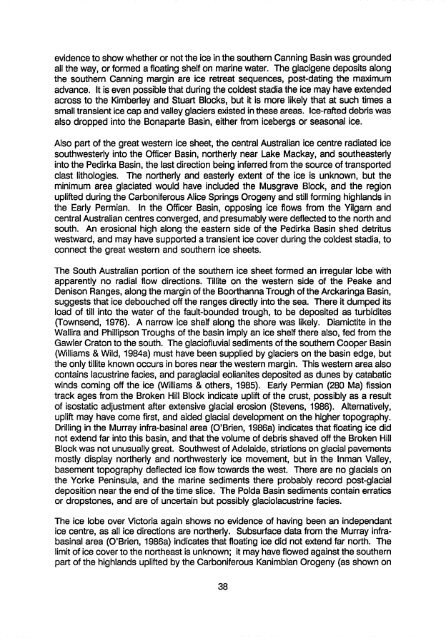II II II II II - Geoscience Australia
II II II II II - Geoscience Australia
II II II II II - Geoscience Australia
You also want an ePaper? Increase the reach of your titles
YUMPU automatically turns print PDFs into web optimized ePapers that Google loves.
evidence to show whether or not the ice in the southern Canning Basin was grounded<br />
all the way, or formed a floating shelf on marine water. The glacigene deposits along<br />
the southern Canning margin are ice retreat sequences, post-dating the maximum<br />
advance. It is even possible that during the coldest stadia the ice may have extended<br />
across to the Kimberley and Stuart Blocks, but it is more likely that at such times a<br />
small transient ice cap and valley glaciers existed in these areas. Ice-rafted debris was<br />
also dropped into the Bonaparte Basin, either from icebergs or seasonal ice.<br />
Also part of the great western ice sheet, the central <strong>Australia</strong>n ice centre radiated ice<br />
southwesterly into the Officer Basin, northerly near Lake Mackay, and southeasterly<br />
into the Pedirka Basin, the last direction being inferred from the source of transported<br />
clast lithologies. The northerly and easterly extent of the ice is unknown, but the<br />
minimum area glaciated would have included the Musgrave Block, and the region<br />
uplifted during the Carboniferous Alice Springs Orogeny and still forming highlands in<br />
the Early Permian. In the Officer Basin, opposing ice flows from the Yilgarn and<br />
central <strong>Australia</strong>n centres converged, and presumably were deflected to the north and<br />
south. An erosional high along the eastern side of the Pedirka Basin shed detritus<br />
westward, and may have supported a transient ice cover during the coldest stadia, to<br />
connect the great western and southern ice sheets.<br />
The South <strong>Australia</strong>n portion of the southern ice sheet formed an irregular lobe with<br />
apparently no radial flow directions. Tillite on the western side of the Peake and<br />
Denison Ranges, along the margin of the Boorthanna Trough of the Arckaringa Basin,<br />
suggests that ice debouched off the ranges directly into the sea. There it dumped its<br />
load of till into the water of the fault-bounded trough, to be deposited as turbidites<br />
(Townsend, 1976). A narrow ice shelf along the shore was likely. Diamictite in the<br />
Wa!lira and Phillipson Troughs of the basin imply an ice shelf there also, fed from the<br />
Gawler Craton to the south. The glaciofluvial sediments of the southern Cooper Basin<br />
(Williams & Wild, 1984a) must have been supplied by glaciers on the basin edge, but<br />
the only tillite known occurs in bores near the western margin. This western area also<br />
contains lacustrine facies, and paraglacial eolianites deposited as dunes by catabatic<br />
winds coming off the ice (Williams & others, 1985). Early Permian (280 Ma) fission<br />
track ages from the Broken Hill Block indicate uplift of the crust, possibly as a result<br />
of isostatic adjustment after extensive glacial erosion (Stevens, 1986). Alternatively,<br />
uplift may have come first, and aided glacial development on the higher topography.<br />
Drilling in the Murray infra-basinal area (O'Brien, 1986a) indicates that floating ice did<br />
not extend far into this basin, and that the volume of debris shaved off the Broken Hill<br />
Block was not unusually great. Southwest of Adelaide, striations on glacial pavements<br />
mostly display northerly and northwesterly ice movement, but in the Inman Valley,<br />
basement topography deflected ice flow towards the west. There are no glacials on<br />
the Yorke Peninsula, and the marine sediments there probably record post-glacial<br />
deposition near the end of the time slice. The PoIda Basin sediments contain erratics<br />
or dropstones, and are of uncertain but possibly glaciolacustrine facies.<br />
The ice lobe over Victoria again shows no evidence of having been an independant<br />
ice centre, as all ice directions are northerly. Subsurface data from the Murray infrabasinal<br />
area (O'Brien, 1986a) indicates that floating ice did not extend far north. The<br />
limit of ice cover to the northeast is unknown; it may have flowed against the southern<br />
part of the highlands uplifted by the Carboniferous Kanimblan Orogeny (as shown on<br />
38

















